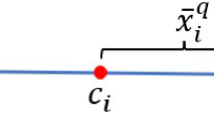Abstract
Particle Swarm Optimization (PSO) is a population-based technique for optimization, which simulates the social behavior of the bird flocking, a novel Adaptive Cooperative PSO (ACPSO) with adaptive search is presented in this paper, the proposed approach combines both cooperative learning and PSO with adaptive inertia weight, cooperative learning is achieved by splitting a high-dimensional swarm into several smaller-dimensional subswarms to combat curse of dimensionality, the adaptive inertia weight is employed to control the balance of exploration and exploitation in all the smaller-dimensional subswarms, which cooperate with each other by exchanging information to determine composite fitness of the entire system. Finally, computer simulations over three benchmarks indicate that the proposed algorithm shows better convergence behavior, as compared to the Cooperative Genetic Algorithm (COGA), the PSO, and the CPSO, and then its adaptive search behavior is analyzed, demonstrating its superiority.





Similar content being viewed by others
References
Kennedy, J., & Eberhart, R. C. (1995). Particle swarm optimization. In Proc. IEEE international conference on neural networks (Vol. 4, pp. 1942–1948).
Afsahi, Z., & Meybodi, M. R. (2009). Improving cooperative PSO using fuzzy logic. In SGAI conf. (pp. 219–232).
Maitra, M., & Chatterjee, A. (2008). A hybrid cooperative-comprehensive learning based PSO algorithm for image segmentation using multilevel thresholding. Expert Systems with Applications, 34(2), 1341–1350.
El-Abd, M., & Kamel, M. S. (2008). A taxonomy of cooperative particle swarm optimizers. International Journal of Computational Intelligence Research, 4(2), 137–144.
Gzara, F., & Erkut, E. (2011). Telecommunications network design with multiple technologies. Telecommunications Systems, 46(2), 149–161.
Du, Y., Wu, Q., Jiang, C., & Li, Z. (2008). Improved cooperative particle swarm optimizer for design of fuzzy neural network control system. Control and Decision, 23(12), 1327–1337.
Li, M., Li, W., & Yang, C.-w. (2010). An improved cooperative PSO algorithm. In Proceedings of the 8th World Congress on intelligent control and automation (pp. 3256–3260).
Eberhart, R. C., & Shi, Y. (2000). Comparing inertia weights and constriction factors in particle swarm optimization. In Proceedings of the Congress on evolutionary computation (pp. 84–88).
Clerc, M., & Kennedy, J. (2002). The particle swarm-explosion, stability and convergence in a multidimensional complex space. IEEE Transactions on Evolutionary Computation, 6, 58–73.
El-Zonkoly, A. (2005). Particle swarm optimization for solving the problem of transmission systems and generation expansion. Nansoura Engineering, 30(1), 201–206.
Zhao, W., Kang, Y., Pan, G., & Huang, X. (2001). Fault diagnosis of power transformer based on BP combined with genetic algorithm. Communications in Computer and Information Science, 134, 33–38.
Reza, F., Abdul, T., Zaiton, S., & Ngah, R. (2007). New particle swarm optimizer with sigmoid increasing inertia weight. International Journal of Computer Science and Security, 1(2), 35–44.
Liu, B., Wang, L., & Jin, Y. H. (2005). Improved particle swarm optimization combined with chaos. Chaos, Solitons and Fractals, 25, 1261–1271.
Ramakrishnan, S., & Emary, I. M. (2011). Classification brain MR images through a fuzzy multiwavelets based GMM and probabilistic neural networks. Telecommunications Systems, 46(3), 245–252.
Zhao, W., Xia, Z., & Chang, X. (2011). An improved bacterial foraging optimization with fuzzy step size. Information, 14(3), 725–730.
Potter, M. A., & de Jong, K. A. (1994). A cooperative coevolutionary approach to function optimization. In The third parallel problem solving from nature (pp. 249–257). Berlin: Springer.
Acknowledgements
This work is supported by the Natural Science Foundation of Hebei Province of China No. E2010001026.
Author information
Authors and Affiliations
Corresponding author
Additional information
The author gratefully acknowledges the support of the Natural Science Foundation of Hebei Province of China.
Rights and permissions
About this article
Cite this article
Wang, L. An improved cooperative particle swarm optimizer. Telecommun Syst 53, 147–154 (2013). https://doi.org/10.1007/s11235-013-9688-z
Published:
Issue Date:
DOI: https://doi.org/10.1007/s11235-013-9688-z




